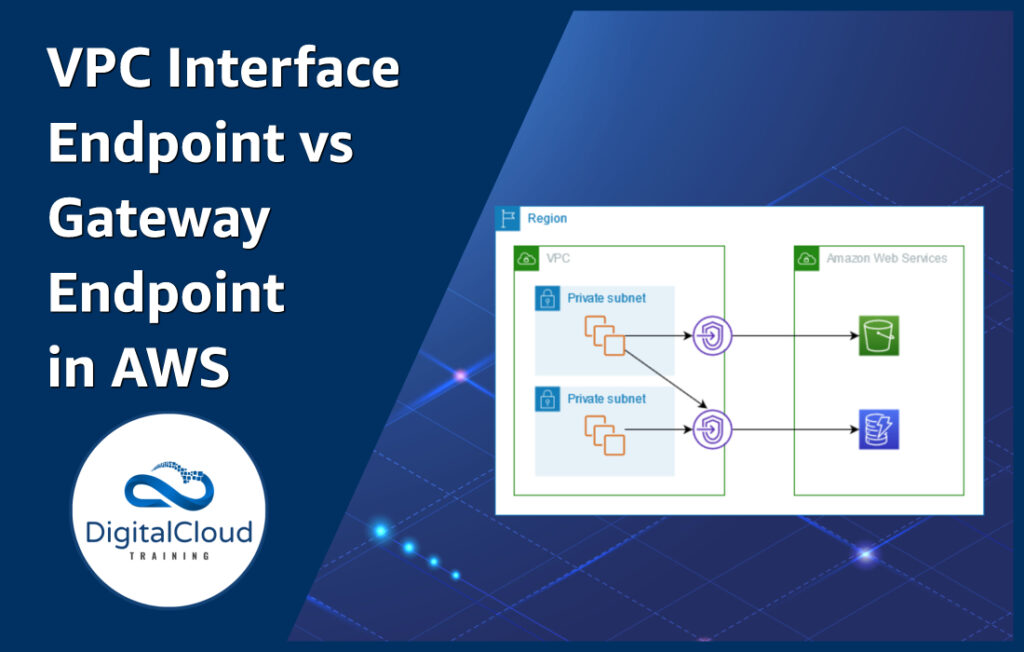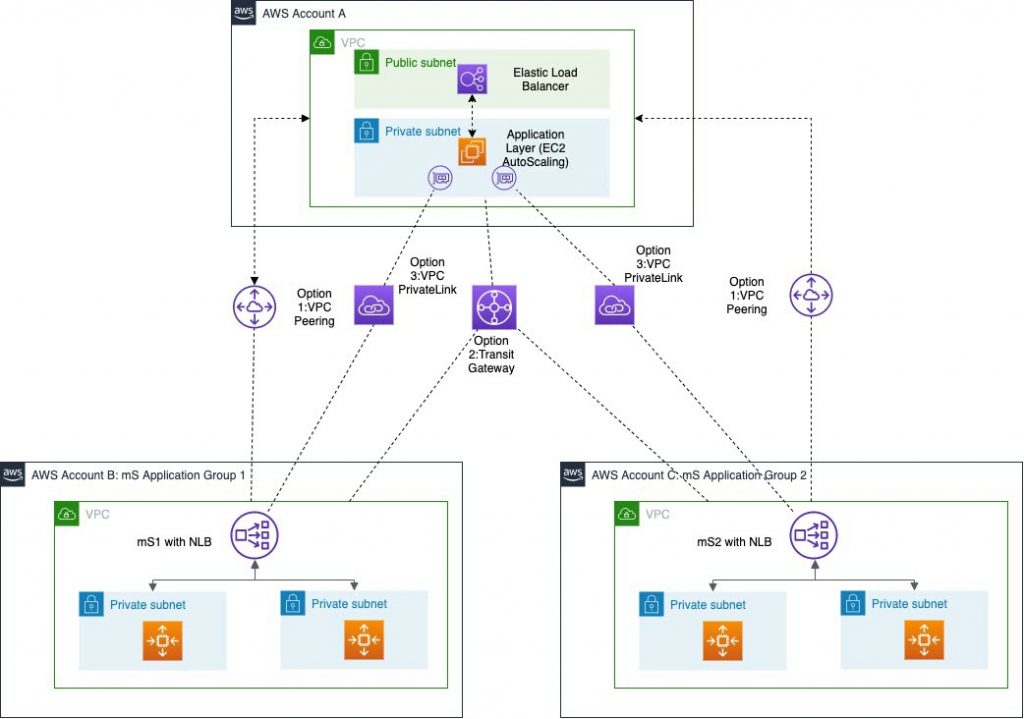What are AWS VPC Endpoints?
AWS Virtual Private Cloud (VPC) Endpoints enable secure connections between Amazon Web Services (AWS) services and resources within a Virtual Private Cloud (VPC) without using public internet gateways or NAT devices. This private connection helps maintain network security and data privacy, ensuring that data does not traverse the public internet. AWS VPC Endpoints support various services, including Amazon S3, Amazon DynamoDB, and AWS Lambda, among others.
AWS VPC Endpoints come in two types: Gateway Endpoints and Interface Endpoints. Gateway Endpoints are used for AWS services that support AWS’s VPC endpoint service, such as Amazon S3 and Amazon DynamoDB. Interface Endpoints, powered by AWS PrivateLink, allow connections to services that do not support VPC Endpoint service but are available on AWS Marketplace. These endpoints provide a more secure and efficient way to transfer data compared to traditional internet-routed data transfers.
How is AWS VPC Endpoint Pricing Structured?
AWS VPC Endpoint pricing is based on a pay-per-use model, which includes data transfer charges, interface VPC endpoint fees, and gateway VPC endpoint fees. Understanding this pricing structure is crucial for effective cost management.
- Data Transfer Charges: AWS charges for data transfer based on the volume of data transferred between the VPC and the connected AWS service. Data transfer within the same region is typically free, but charges may apply for data transferred between regions. It is essential to monitor data transfer volumes to avoid unexpected costs.
- Interface VPC Endpoint Fees: Interface VPC Endpoints, powered by AWS PrivateLink, incur fees based on the number of connections and the data transferred. These fees include an hourly connection charge and a data transfer charge. The hourly connection charge is based on the number of active connections, while the data transfer charge is based on the volume of data transferred.
- Gateway VPC Endpoint Fees: Gateway VPC Endpoints, which support services like Amazon S3 and Amazon DynamoDB, do not have additional fees beyond data transfer charges. However, it is still necessary to monitor data transfer volumes to avoid unexpected costs.
By understanding the pricing structure, organizations can effectively manage their AWS VPC Endpoint costs and optimize their usage. Monitoring usage, optimizing data transfer patterns, and setting up billing alerts are some best practices for managing AWS VPC Endpoint costs.
Comparing AWS VPC Endpoint Pricing with Internet-Routed Data Transfers
AWS VPC Endpoints offer a more secure and efficient way to transfer data compared to traditional internet-routed data transfers. However, understanding the cost differences between the two is crucial for effective cost management.
- Data Transfer Costs: Internet-routed data transfers typically involve higher data transfer costs due to the need for additional network infrastructure and security measures. AWS VPC Endpoints, on the other hand, offer lower data transfer costs by eliminating the need for public internet gateways or NAT devices.
- Security Costs: AWS VPC Endpoints provide enhanced security features, such as private connections and encryption, which can help reduce the costs associated with implementing and maintaining security measures for internet-routed data transfers.
- Performance Costs: AWS VPC Endpoints offer lower latency and higher bandwidth compared to internet-routed data transfers, which can result in better performance and lower costs associated with downtime or slow data transfer speeds.
Scenarios where VPC Endpoints can provide cost savings include applications that require high-volume data transfers, applications that require enhanced security features, and applications that require low-latency and high-bandwidth connections.
How to Estimate AWS VPC Endpoint Costs
Estimating AWS VPC Endpoint costs is essential for effective cost management. Here are the factors to consider and a step-by-step guide on how to use the AWS Pricing Calculator to estimate costs.
- Data Transfer Volumes: The volume of data transferred between the VPC and the connected AWS service is a significant factor in estimating costs. Higher data transfer volumes will result in higher costs.
- Number of Endpoints: The number of VPC Endpoints used in your infrastructure will also impact costs. More endpoints will result in higher connection and data transfer fees.
- Region-Specific Pricing: AWS charges different prices for VPC Endpoints based on the region. Ensure you consider the region-specific pricing when estimating costs.
Here’s a step-by-step guide on how to use the AWS Pricing Calculator to estimate costs:
- Go to the AWS Pricing Calculator website.
- Click on “Create estimate” to start a new estimate.
- Add products: Search for “VPC Endpoint” and add it to your estimate.
- Configure the VPC Endpoint: Select the type (Gateway or Interface), region, and other relevant details.
- Add usage details: Enter the estimated data transfer volumes and number of endpoints.
- Review and save: Review your estimate and save it for future reference.
By estimating costs accurately, organizations can effectively manage their AWS VPC Endpoint costs and avoid unexpected charges.
Best Practices for Managing AWS VPC Endpoint Costs
Managing AWS VPC Endpoint costs is essential for effective cost management. Here are some best practices to help organizations stay within their budget:
- Monitor Usage: Regularly monitor the usage of your VPC Endpoints to identify any unexpected charges or data transfer patterns. AWS provides various tools, such as CloudWatch and Cost Explorer, to help monitor usage and costs.
- Optimize Data Transfer Patterns: Optimize data transfer patterns by minimizing data transfer volumes and using caching mechanisms to reduce the number of requests. This can help reduce data transfer charges and improve performance.
- Set Up Billing Alerts: Set up billing alerts to notify you when your costs exceed a certain threshold. This can help you take action before the costs get out of control.
- Review and Adjust Endpoints: Regularly review and adjust the number of endpoints based on your current needs. Decommission any unused endpoints to avoid unnecessary fees.
- Consider Reserved Endpoints: AWS offers Reserved Endpoints, which provide a discounted rate for a committed usage period. Consider using Reserved Endpoints if you have a consistent need for VPC Endpoints.
By following these best practices, organizations can effectively manage their AWS VPC Endpoint costs and avoid unexpected charges.
Real-World Examples of AWS VPC Endpoint Cost Optimization
Organizations across various industries have successfully optimized their AWS VPC Endpoint costs. Here are some real-world examples and strategies they used:
- Media Company: A media company reduced their data transfer costs by optimizing their data transfer patterns. They used caching mechanisms to reduce the number of requests and minimized data transfer volumes. As a result, they achieved a 30% reduction in their VPC Endpoint costs.
- Financial Institution: A financial institution used AWS Cost Explorer to monitor their VPC Endpoint usage and set up billing alerts. By doing so, they were able to identify and decommission unused endpoints, reducing their VPC Endpoint fees by 25%. They also used Reserved Endpoints to commit to a consistent usage period, achieving a further 15% discount.
- E-commerce Platform: An e-commerce platform used AWS Organizations to consolidate their VPC Endpoint usage across multiple accounts. By doing so, they were able to take advantage of volume discounts and achieve a 20% reduction in their VPC Endpoint costs.
These examples demonstrate the importance of implementing best practices for managing AWS VPC Endpoint costs. By monitoring usage, optimizing data transfer patterns, and setting up billing alerts, organizations can achieve significant cost savings.
Staying Up-to-Date with AWS VPC Endpoint Pricing Changes
Staying informed about AWS VPC Endpoint pricing changes is crucial for effective cost management. AWS regularly updates its pricing structure to provide more value and cost savings to its customers. Here’s how to stay up-to-date with AWS VPC Endpoint pricing changes:
- Subscribe to AWS Notifications: AWS provides a notification service that allows you to stay informed about pricing changes, product updates, and other relevant news. To subscribe, go to the AWS Management Console, navigate to the “My Account” section, and select “Preference and Notifications.” From there, you can subscribe to the AWS Price Alert Newsletter.
- Follow AWS Blogs and Social Media: AWS regularly updates its pricing changes on its official blogs and social media channels. Follow AWS on Twitter, LinkedIn, or Facebook to stay informed about the latest pricing updates.
- Check the AWS Pricing Page: AWS regularly updates its pricing page with the latest pricing information. Bookmark the AWS VPC Endpoint pricing page and check it regularly for any updates.
By staying informed about AWS VPC Endpoint pricing changes, organizations can take advantage of cost savings and optimize their VPC Endpoint usage. Regularly reviewing and adjusting your VPC Endpoint usage based on pricing changes can help you stay within your budget and achieve your cost optimization goals.
Conclusion: Maximizing Cost Efficiency with AWS VPC Endpoints
AWS VPC Endpoints offer a secure and efficient way to connect to AWS services, but it’s essential to understand the pricing structure and best practices for managing costs. By estimating costs, monitoring usage, optimizing data transfer patterns, and setting up billing alerts, organizations can stay within their budget and achieve their cost optimization goals.
Real-world examples demonstrate the value of optimizing AWS VPC Endpoint costs. By implementing best practices, organizations have achieved significant cost savings and improved their overall cloud infrastructure’s efficiency. Staying informed about AWS VPC Endpoint pricing changes is also crucial for effective cost management.
Incorporating innovative and creative concepts, such as using caching mechanisms, consolidating VPC Endpoint usage across multiple accounts, and using Reserved Endpoints, can provide additional cost savings. By following the best practices outlined in this guide, organizations can maximize their cost efficiency with AWS VPC Endpoints and achieve their desired business outcomes.
Take action today and optimize your AWS VPC Endpoint costs. For further learning, explore the AWS documentation, webinars, and online courses on AWS VPC Endpoints and cost optimization.







